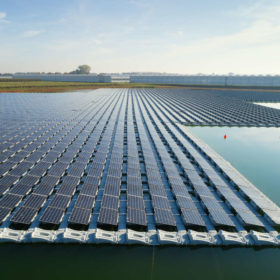CATL launches 500 Wh/kg condensed matter battery
Chinese battery industry heavyweight CATL has unveiled a novel condensed matter battery technology with an energy density of up to 500 Wh/kg. The company said it can achieve mass production within this year.
Producing the goods
Germany’s Fraunhofer Institute for Solar Energy Systems (ISE) is demonstrating how a solar-powered refrigeration unit and dryer could be self-sustaining and improve food security in Kenya.
Weekend read: High time for solar
Cannabis prohibition drove a culture of clandestine production in the past and solar helped growers to cultivate it at remote, off-grid sites. Now, as a global commercial cannabis market emerges, solar has an even bigger role to play.
Dutch city installs solar footpath
Hungary’s Platio has inaugurated a solar footpath in the Dutch city of Groningen. The installation consists of 2,544 monocrystalline Patio solar pavers with a 21.8% efficiency rating. It will generate 55,000 kWh of electricity per year and can purportedly withstand a pressure of 2 tons without microcracks.
Weekend Read: Industry and researchers in tandem
As efficiency records tumble and devices become more stable, Europe is seeing the beginnings of a race to commercialize high-efficiency perovskite-silicon tandem solar products, reports Valerie Thompson.
Belgian developer starts digging hole for geothermal heat pumps in Bruges
Property developer Steenoven and an undisclosed construction contractor have started drilling a borehole for a new thermal energy storage system in the historic city of Bruges, Belgium.
Fortune favors the brave
The renewables industry fears that the new energy bill that the French government is preparing could make clean power generation even tougher. However, solar analyst Xavier Daval says that betting everything on the nation’s nuclear power fleet is a risky strategy.
Weekend Read: Shingle all the way
While shingled cells have been around for a while, Tongwei’s adoption of the technology is notable as it is a manufacturer with considerable scale. If shingling can overcome some hurdles, it could prove a welcome solution as unshaded sites for PV become elusive in mature solar markets.
Enel starts building 170 MW of agrivoltaics in Italy
Enel Green Power says it has started working on the largest agrivoltaics plant in Italy. It will feature bifacial PV modules mounted on trackers. Olive trees will grow around the solar panel rows.
Global study highlights potential of floating solar
An international group of researchers has calculated the potential for floating solar across the world. The results show a generation potential of 9,434 TWh per year across 114,555 global reservoirs, with 30% of their area covered. The United States leads with 1,911 TWh per year of potential, followed by China at 1,107 TWh per year and Brazil at 865 TWh per year.










